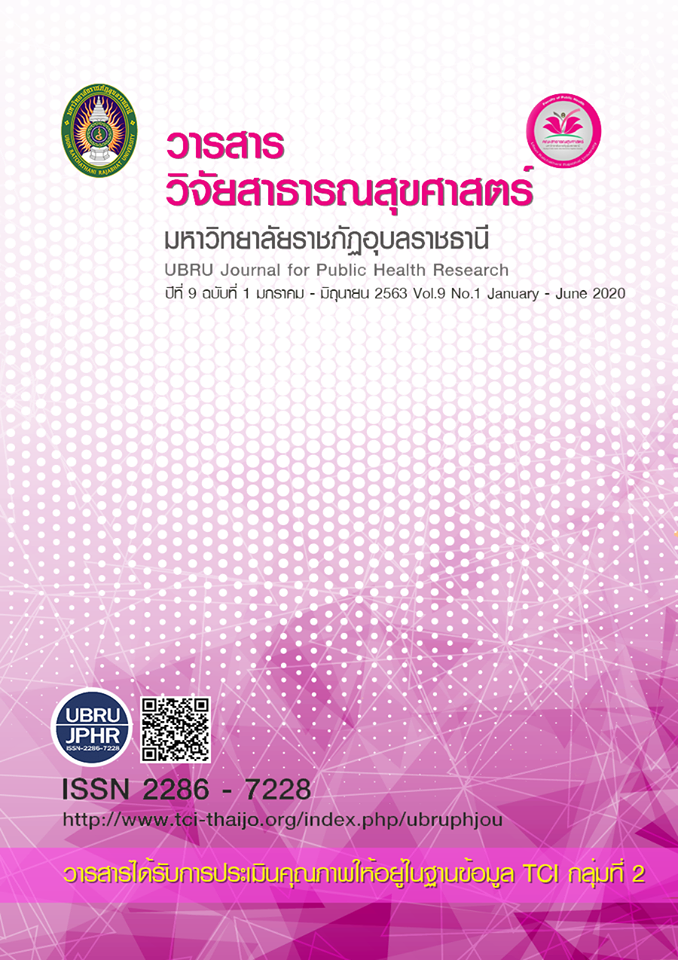Risk behaviors and prevention behaviors of liver fluke infection: Situation assessment based on community context of Thai-Khmer people in Sisaket Province
Keywords:
Risk behaviors, prevention behaviors, Thai-Khmer people, liver flukeAbstract
Liver fluke is a major public health problem in Thailand. It is the main cause of cholangiocarcinoma. Liver fluke infection is spread in people of all age groups and occupations in the northeast region, which is the region with diversity in arts, culture and traditions in each locality. These arts and culture are the indicators of the beliefs, values and ways of life of the local people. The reason that this region is diverse in arts and culture may be the result of being the center of multi-ethnic populations. Sisaket Province is classified as a multicultural society. There 4 ethnic groups, namely Laos, Khmer, Suay (Kui) and Yer. Each ethnic group has their own beliefs, values and ways of life that are unique, so each ethnic group may have different risk behaviors and liver fluke prevention behaviors. Therefore, the study of risk behaviors and prevention behaviors of liver fluke infection in the community context of Thai-Khmer people in Sisaket Province will be used as the information for organizing further health education program for behavior modification.
This was cross-sectional research conducted from February to May 2018. Data were collected from people living in the community of Thai-Khmer people in Sisaket Province. The questionnaire on risk behaviors and prevention behaviors of liver fluke infection created by the researcher was used. The reliability of the whole questionnaire was 0.93. Data were analyzed using descriptive statistics, namely frequency, percentage, mean, and standard deviation.
The results showed that the risk behaviors for liver fluke infection of most people were eating Pla Jom (fermented and sour fish)/raw fish, allowing dogs/cats to eat raw fish and eating papaya salad with raw fermented fish. In addition, some family members still defecated in the rice fields. Although the result of the assessment of liver fluke prevention behaviors of the majority of people was at a high level (76.40%), the results of the survey of liver fluke infection revealed that the average prevalence of liver fluke infection was 17.02%, which exceeded the standard set by the Ministry of Public Health of not over 5%. Therefore, this research is important for the assessment of the situation of the spread of the disease and recognizing the causes of risk behaviors for liver fluke infection of people in the area. It can be also utilized in the planning of public health operations in the future.
References
นำพร อินสิน, ศศิวรรณ ทัศนเอี่ยม และกาญจณา วงษ์สวัสดิ์. (2560). พฤติกรรมเสี่ยงต่อโรคมะเร็งท่อน้ำดีและการรับรู้การป้องกันโรคมะเร็งท่อน้ำดีของนักเรียนระดับชั้นประถมศึกษาปีที่ 4-5-6: กรณีศึกษาโรงเรียนในตำบลม่วงลาย อำเภอเมือง จังหวัดสกลนคร. วารสารวิจัยสาธารณสุขศาสตร์ มหาวิทยาลัยขอนแก่น. 10(1), 63-72.
ประเสริฐ ประสมรักษ์. (2562). เปรียบเทียบความชุกของการติดเชื้อพยาธิใบไม้ตับ ความรู้และพฤติกรรมป้องกันในประชากรกล่มเสี่ยงพื้นที่รอบแหล่งน้ำชุมชนชนบทและชุมชนเมือง. ศรีนครินทร์เวชสาร. 34(6), 628-634.
สารภี ขาวดี. (2555). บทบาทหน้าที่ของพิธีกรรม "การโจลมะม็วด" ต่อชุมชนเขมร จังหวัดสุรินทร์. วารสารศิลปศาสตร์ มหาวิทยาลัยอุบลราชธานี. 8(1), 153-196.
สำนักงานสาธารณสุขจังหวัดศรีสะเกษ. (2559). สรุปรายงานการควบคุมโรคหนอนพยาธิ. ศรีสะเกษ: สำนักงานสาธารณสุขจังหวัดศรีสะเกษ.
สำนักงานสาธารณสุขอำเภอขุขันธ์. (2559). สรุปรายงานการควบคุมโรคหนอนพยาธิ. ศรีสะเกษ: สำนักงานสาธารณสุขอำเภอขุขันธ์.
อังษณา ยศปัญญา, สุพรรณ สายหลักคำ, บุญจันทร์ จันทร์มหา และเกษร แถวโนนงิ้ว. (2558). ความชุกและปัจจัยที่มีผลต่อการเกิดโรคพยาธิใบไม้ตับ จังหวัดเลย ปี 2556. วารสารสำนักงานป้องกันควบคุมโรคที่ 6 จังหวัดขอนแก่น. 22(1), 89-97.
IARC. (2012). Opisthorchis viverrini and Clonorchis sinensis. IARC working group on the evaluation of carcinogenic risks to humans. IARC Monogr Eval Carcinog Risks Hum. 100B, 1-498.
Kaewpitoon, N., Kaewpitoon, S.J., Pengsaa, P., & Pilasri, C. (2007). Knowledge, attitude and practice related to liver fluke infection in northeast Thailand. World J Gastroenterol. 13(12), 1837-1840.
Manwong, M., Songserm, N., Promthet, S., & Matsuo, K. (2013). Risk factors for cholangiocarcinoma in the lower part of Northeast Thailand: a hospital-based case-control study. Asian Pac J Cancer Prev. 14(10), 5953-5956.
Sithithaworn, P., Andrews, R.H., Nguyen, V.D., Wongsaroj, T., Sinuon, M., Odermatt, P., et al. (2012). The current status of opisthorchiasis and clonorchiasis in the Mekong Basin. Parasitol Int. 61(1), 10-16.
Songserm, N., Bureelerd, O., Thongprung, S., Woradet, S., Promthet, S. (2015). Community participation in cholangiocarcinoma prevention in Ubon Ratchathani, Thailand: relations with age and health behavior. Asian Pac J Cancer Prev. 16(16), 7375-7379.
Songserm, N., Promthet, S., Sithithaworn, P., Pientong, C., Ekalaksananan, T., Chopjitt, P., et al. (2011). MTHFR polymorphisms and Opisthorchis viverrini infection: a relationship with increased susceptibility to cholangiocarcinoma in Thailand. Asian Pac J Cancer Prev. 12(5), 1341-1345.
Songserm, N., Promthet, S., Sithithaworn, P., Pientong, C., Ekalaksananan, T., Chopjitt, P., et al. (2012). Risk factors for cholangiocarcinoma in high-risk area of Thailand: role of lifestyle, diet and methylenetetrahydrofolate reductase polymorphisms. Cancer Epidemiol. 36, e89-94.
Sripa, B., Kaewkes, S., Sithithaworn, P., Mairiang, E., Laha, T., Smout, M., et al. (2007). Liver fluke induces cholangiocarcinoma. PLoS Med. 4(7), e201.
Downloads
Published
How to Cite
Issue
Section
License
เนื้อหาและข้อมูลในบทความที่ลงตีพิมพ์ในวารสารวารสารวิจัยสาธารณสุขศาสตร์ มหาวิทยาลัยราชภัฏอุบลราชธานี ถือเป็นข้อคิดเห็นและความรับผิดชอบของผู้เขียนบทความโดยตรงซึ่งกองบรรณาธิการวารสาร ไม่จำเป็นต้องเห็นด้วย หรือร่วมรับผิดชอบใดๆ
บทความ ข้อมูล เนื้อหา รูปภาพ ฯลฯ ที่ได้รับการตีพิมพ์ในวารสารนี้ ถือเป็นลิขสิทธิ์ของวารสารฯ หากบุคคลหรือหน่วยงานใดต้องการนำทั้งหมดหรือส่วนหนึ่งส่วนใดไปเผยแพร่ต่อหรือเพื่อกระทำการใดๆ จะต้องได้รับอนุญาตเป็นลายลักอักษรณ์จากบรรณาธิการวารสารนี้ก่อนเท่านั้น


